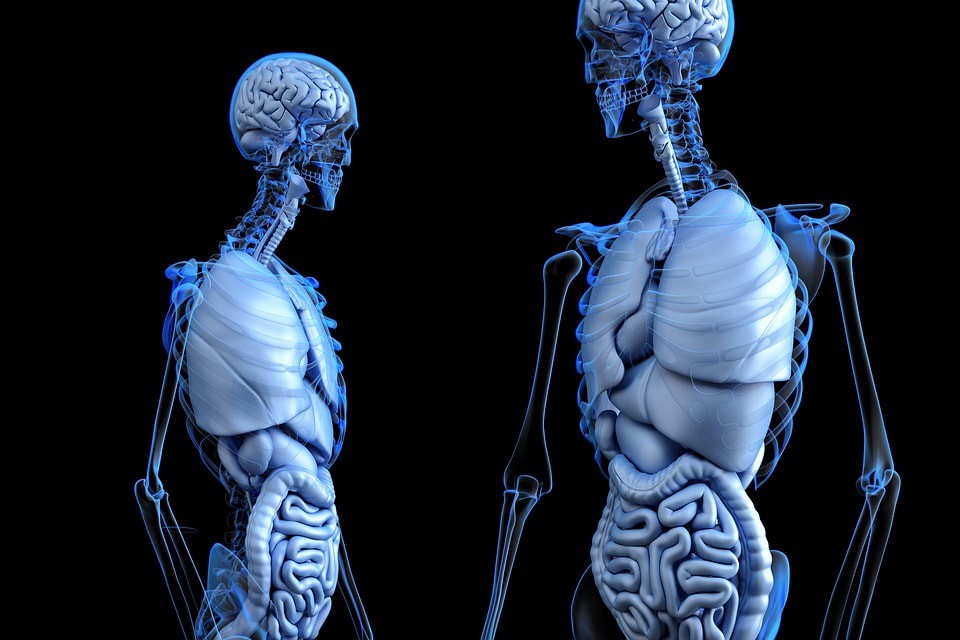Although nothing ever quite lives up to the hype, Human Growth Hormone (hGH) comes close. When we think of hGH, however, we sometimes recall the bison-headed athletes of two decades ago who abused it as a PED (I won’t mention BB’s name here). Truth is, even though numerous celebrities along with the rich and famous are flocking to get hGH injections via the thousands of “anti-aging” clinics that have sprung up over the last decade, there can be side effects.
However, side effects come when using exogenous forms — typically injectables (as opposed to the endogenous hGH made by your body), which I will not be promoting or discussing today beyond warning people that peer review has shown that abuse can lead to INSULIN RESISTANCE / DIABETES, muscle and joint pain, vision problems, VERTIGO, HEADACHES, SLEEP APNEA, and a host of others, many of which are associated with something called acromegaly — a disorder associated with excess endogenous production.
Growth hormone (hGH) is one of the seven hormones secreted by the anterior (front) portion of the pituitary gland. It’s purpose? It’s the hormone (it’s often referred to as “anabolic” because it’s a ‘builder’) that floods the system early in life for the express purpose of stimulating growth. The chief way that it works is by increasing COLLAGEN SYNTHESIS via stimulating one of the single most anabloic hormones in the body, insulin-like growth factor-1 (IGF-1). It also acts to increase fat metabolism, while sparing lean body mass (muscle).
The September 2011 issue of Frontiers in Endocrinology (The Intricate Role of Growth Hormone in Metabolism) revealed that hGH “modulates metabolism and energy homeostasis… and metabolic actions in various tissues, including the liver, adipose tissue, skeletal muscle, and pancreas.” Think about this because it means that the insulin resistance and diabetes mentioned above can frequently be successfully addressed by addressing endogenous hGH production.
Unfortunately, there is a wrench thrown into the gears of all of us. After the age of 20, hGH production begins a serious decline, and by age 30, it’s in free fall, with production levels diminishing by about 15 percent annually. By the time we are 60, levels have been shown to be about 20% of their high. What happens as these levels decrease? Naturally, we get the age-associated changes that are at least on some level, universal to all of us. However, there are things we can do to at least modify the natural course of things.
The April 2012 issue of Pathobiology of Aging and Age Related Disease (Growth Hormone, Inflammation and Aging) revealed that when the hGH levels of “long living” or (pay attention) “calorie-restricted” animals were studied, there was….
“….decreased pro-inflammatory activity with increased levels of anti-inflammatory adipokines. At the same time, these animals have improved insulin signaling and carbohydrate homeostasis that relate to alterations in the secretory profile of adipose tissue including increased production and release of anti-inflammatory adipokines. This suggests that reduced inflammation promoting healthy metabolism may represent one of the major mechanisms of extended longevity.”
This is a huge deal because fat itself (adipose tissue) acts as its own unholy endocrine organ (HERE).
In other words, hGH significantly diminished age-related INFLAMMATION, which also happens to be the root cause of most chronic pain, chronic illness, and aging. If we go back and look at a study from a 20 year old issue of the Journal of Clinical Endocrinology and Metabolism (Growth Hormone Deficiency in Adulthood and the Effects of Growth Hormone Replacement: A Review) we see a list of features characterizing someone with abnormally low levels of hGH (links are mine)
- Reduced lean body mass (less muscle mass)
- Increase body fat (particularly ABDOMINAL OBESITY)
- Reduces strength and capacity to exercise
- Reduced vitality and energy (SEX DRIVE included)
- Reduced fertility (HERE)
- Impaired psychological well being (ANXIETY / DEPRESSION)
- Emotional lability (drastic mood changes, often occurring one-after-the-other in rapid succession)
- Impaired self control (often leading to addictions HERE and HERE are examples)
- Increased social isolation
- Thin, dry skin, frequently cold with poor circulation (symptoms of THYROID DEFICIENCY — realize that TSH is also made in the anterior pituitary.)
- Weak bones (OSTEOPOROSIS)
- Cardiovascular problems (“adults with hypopituitarism have reduced life expectancy, with a greater than 2-fold increase in mortality from cardiovascular disease.“)
- Insulin resistance (“GH-deficient adults have hyperinsulinemia, indicating insulin resistance. These features are associated with the central obesity and increased intraabdominal adiposity that are characteristic of GH deficiency.“)
- Sleep issues (as you’ll soon see, hGH and sleep are intimately related.)
- Others
Suffice it to say that this list could have been longer. And while it’s possible to get prescriptions for hGH (the basis of the “anti-aging” industry seen in areas with high concentrations of wealthy retirees, or prescribed to children who are not making enough of the hormone themselves) or purchase it on the black market as a muscle-building ‘steroid,’ you cannot, despite all sorts of ads to the contrary, purchase it as a supplement (hGH ‘supplements’ contain precursors and products touted for their ability to increase endogenous production).
INCREASING hGH LEVELS STEP I: LOW GLYCEMIC MEALS

I’ve shown you time and time again that if you want to foul your body’s ENDOCRINOLOGICAL HOMESTASIS in about a million ways, just eat a lot of SUGAR OR HIGH GLYCEMIC PROCESSED CARBOHYDRATES on a regular basis. It’s arguably the quickest way to screw your body up in ways that science is just now starting to understand (HERE is a classic example — “Sugar Turns Men Into Women and Women Into Men“). What do we know about carbs and hGH? Let’s take a look.
Because 1/3 of our population is outright obese and another 50% is either overweight or APPEARS THAT WAY on blood tests, this study (Elevated Insulin Levels Contribute to the Reduced Growth Hormone (GH) Response to GH-Releasing Hormone in Obese Subjects) from a 1999 issue of Metabolism is far more relevant today than when it was published two decades ago.
“In conclusion, our data indicate that in the obese, as in normal subjects, the GH response to Growth Hormone Releasing Hormone (GHRH) is a function of insulin levels. The finding that after both treatments the obese still show higher insulin levels and a lower GH response to GHRH than normal subjects suggests that hyperinsulinemia is a major determinant of the reduced GH release associated with obesity.”
In other words, jack your insulin levels by LIVING THE HIGH CARB LIFESTYLE and boom — you’ve just adversely affected GH production in a manner that’s arguably the strongest. A 1985 study in the journal Endocrinology (Insulin Suppresses Triiodothyronine-Induced Growth Hormone Secretion by GH3 Rat Pituitary Cells) showed something equally as freaky.
The active form of thyroid hormone (T3) stimulates production of hGH. But not if you are having your cake and eating it to. “The data show that physiological doses of insulin antagonize T3-induced stimulation of GH secretion and also partially block the synergistic stimulation of GH by T3.”
Still another study, this one from a 2001 issue of the Journal of Clinical Endocrinology and Metabolism (Abdominal Visceral Fat and Fasting Insulin are Important Predictors of 24-hour GH Release Independent of Age, Gender, and Other Physiological Factors) showed how big a deal belly fat is as far as both insulin and hGH are concerned “Abdominal visceral fat and fasting insulin were consistently important predictors of integrated 24-hr GH concentrations independent of age group, gender, and all other predictor variables.“
These and other studies have made it obvious that a high glycemic load inhibits hGH by increasing circulating insulin and cortisol (adrenal fatigue). Likewise; although I am not going to dwell on the studies here, there are several amino acids, which, along with creatine (Acute Creatine Loading Enhances Human Growth Hormone Secretion from the December 2000 issue of the Journal of Sports Medicine and Physical Fitness), have been shown to increase hGH levels — a reminder that dietary protein is important (considering our bodies are mostly water and proteins, this shouldn’t be difficult to grasp).
And as far as specific foods that are consistently touted for their ability to increase hGH levels, some that are mentioned both in peer-review and any number of online lists include grass-fed beef (grass-fed butter), free-range chicken (and their eggs), fish (COLD WATER), plain Greek yogurt, extra virgin olive oil, avocados, COCONUT OIL, pineapple, Goji berries, citrus fruit, Fava beans, algaes such as Spirulina or Chlorella, BEETS (for the liver), gelatin, and several others including watermelon. While I can’t vouch for any of these per se, there is one dietary regimen bound to increase your body’s production of hGH……
INCREASING hGH LEVELS STEP II: FASTING

When it comes to anything to do with food, there is little consensus among the scientific community. The one thing, however, that everyone seems to agree on, is that when mammals are restricted as to the amount of food they consume (this restriction is typically about 60% of what they would normally eat), they live longer. How can a person get the ‘super powers’ of calorie restriction without the pain or starvation adaptation (your body thinks it’s starving and slows its metabolism accordingly)? How about intermittently fasting?
Although there are any number of ways to do this (I’ve done a number of 10 day fasts over the years but prefer a version where I am consuming my day’s calories between noon and 6pm), FASTING INTERMITTENTLY has some serious peer-reviewed juice behind it, much of it having to do with its ability to increase endogenous hGH production.
For instance, a 1982 study from the journal Medical Progress (Fasting: The History, Pathophysiology and Complications) contained a chart that showed the pre-fasted level of hGH to be .73 ng/ml. Five days into the fast hGH had increased to 300% and by day 26 (I’m not suggesting you do this sort of fast), hGH was a whopping 9.86 ng/ml or 1,350% more than baseline. Allow me to show you a few others showing similarly interesting results.
“Studies in man have shown that the episodic release [“pulse”] of growth hormone (GH) is infrequent and erratic, and unlike that in the rat does not appear to have discernible ultradian periodicities [a normal 24 hour rhythm]…. Accordingly, the 24 hour pulsatile pattern of GH secretion obtained from repetitive venous sampling in six normal adult male subjects was examined during a control fed day and during the first and fifth days of a 5 day fast. The GH data were analyzed using two distinct methods.
The 5 day fast resulted in a significant increase in discrete GH pulse frequency (5.8 vs. 9.9 pulses per 24hrs), 24 hr integrated GH concentration (2.82 vs. 8.75 mcg/ml), and maximal pulse amplitude (5.9 vs. 12.3 ng/ml).” From a 1988 issue of the Journal of Clinical Investigations (Fasting Enhances Growth Hormone Secretion and Amplifies the Complex Rhythms of Growth Hormone Secretion in Man)
“Serum GH concentrations are increased in fasted or malnourished human subjects. Two days of fasting induced a 5-fold increase in the 24-hour endogenous GH production rate (78 vs 371 micrograms). This enhanced GH production rate was accounted for by 2-fold increases in the number of GH secretory bursts per 24 hour period and the mass of GH secreted per burst (6.3 vs 11 micrograms).
In conclusion, the present data suggest that starvation-induced enhancement of GH secretion is mediated by an increased frequency of GH releasing hormone release…..” From a 1992 issue of the Journal of Clinical Endocrinology and Metabolism (Augmented Growth Hormone Secretory Burst Frequency and Amplitude Mediate Enhanced GH Secretion During a Two-Day Fast in Normal Men)
“Decreased 24 hour spontaneous GH release profiles, the decreased GH responses to insulin-induced hypoglycemia and L-arginine, the decreased basal IGF-I levels, as well as the elevated insulin levels were returned to normal after a massive weight loss [on average, 30 lbs] in the obese subjects. The recovery of the 24-hour GH release points to an acquired transient defect rather than a persistent preexisting disorder.” From a 1995 issue of the Journal of Clinical Endocrinology and Metabolism (Massive Weight Loss Restores 24-hour Growth Hormone Release Profiles and Serum Insulin-Like Growth Factor-I Levels in Obese Subjects)
“In this most recent trial, researchers conducted two fasting studies of over 200 individuals — both patients and healthy volunteers — who were recruited at Intermountain Medical Center. A second 2011 clinical trial followed another 30 patients who drank only water and ate nothing else for 24 hours. They were also monitored while eating a normal diet during an additional 24-hour period.
Blood tests and physical measurements were taken from all to evaluate cardiac risk factors, markers of metabolic risk, and other general health parameters. This recent study also confirmed earlier findings about the effects of fasting on human growth hormone (HGH), a metabolic protein. HGH works to protect lean muscle and metabolic balance, a response triggered and accelerated by fasting.
During the 24-hour fasting periods, HGH increased an average of 1,300 percent in women, and nearly 2,000 percent in men.” From the press release of a study done by the 12-member Intermountain Medical Center Heart Institute research team that was presented at the annual meeting of the American College of Cardiology on April 3 of 2011 in New Orleans
Although we are going to address driving hGH via exercise in a moment, due to a bit of overlap I want to address fasted training now. Back in the day everyone was told that the way to lose weight and get leaner and stronger was to eat numerous small meals throughout the day. While this may be the best approach for the “hardgainer” — the person struggling to put on weight (yes, they exist and I used to be one; key words being ‘used to’) — it’s probably not the way to get LEAN AND MEAN IN A HURRY.
People with crazy high metabolisms (younger athletes are most frequently mentioned in this population) must get enough calories or else run a deficit, making significant weight gain all but totally impossible. However, if you want to gain some muscle and get ripped in the process, fasted training might just be the solution you’ve been looking for. That’s because fasted training forces your body to access fat stores for energy. Allow me to give you an example.
Many people have been taught to consume a pre-workout protein shake. What does the research say about this in relation to hGH? A team of Finnish scientists publishing in a 2005 issue of Medicine and Science in Sports and Exercise (Protein Ingestion Prior to Strength Exercise Affects Blood hormones and Metabolism) concluded thusly….. “Consuming 25 g of whey and caseinate proteins 30 min before a heavy strength training session significantly decreases serum growth hormone, testosterone, and free fatty acid levels, and increases serum insulin during the workout…..” And as we saw earlier, eating breakfast before working out was even worse.
I could have turned this post into a treatise for the fat-burning benefits of intermittent fasting, but there is more to increasing your body’s own production of hGH than simply fasting. Because, as we saw moments ago, most hGH is manufactured and released while we sleep, would it make sense that sleep hygiene is a critical part of this scenario?
INCREASING hGH LEVELS STEP III: PROPER SLEEP

Research has shown that most — about 80% — of your body’s hGH production occurs in small bursts while you sleep. It’s why I put sleep ahead of exercise in this post. However, as is the case with all hGH, it breaks down rapidly. If your goal is increasing hGH levels, then in the same way you want to work out in a fasted state, you likewise want to go to sleep in a fasted state (this goes for protein meals or snacks, not just sugary or carb-laden offerings).
This is because research has shown that the highest amounts of hGH are secreted about an hour after falling asleep, and we already know that insulin tends to have an inhibitory effect on endogenous hGH production. Enter MELATONIN.
Melatonin is created from the neurotransmitter SEROTONIN in the pineal gland (a part of the brain not so distant from the pituitary gland). Light signals from the eye are converted to electrochemical messages that provide information to the pineal gland about day and night.
And while melatonin can be produced any time the right precursors are available (serotonin and the amino acid tryptophan being chief among them), it is released almost exclusively at night. Of critical importance is the fact that it does not take much light to suppress the release of melatonin. Listen to what the UK’s Society for Endocrinology says about this.
“Night-time melatonin secretion is suppressed by a relatively dim light when pupils are dilated. This has been suggested as the main way through which prolonged use of devices such as laptops and smartphones before bedtime can have a negative impact on melatonin secretion, circadian rhythms and sleep.”
Adversely affect sleep, and among the many consequences are that you will adversely affect production and release of hGH. Also remember that the amount of melatonin secreted by the pineal gland is directly linked to the number of hours of darkness at night. In other words, winter months equal longer nights, equal more melatonin.
While melatonin has many functions, including regulating other hormones, reproduction, regulating seasonal, diurnal, and circadian rhythms, it is heavily involved in the regulation of human growth hormone; a fact attested to by numerous studies, most having to do with melatonin supplementation of some sort.
Even though studies have overwhelmingly shown that melatonin is a safe and effective supplement for many people, in our more-is-better society, I must mention that it can be overdone. If you are interested you can read the French study that was published clear back in 1997 in the Journal of Biological Rhythms (Toxicology of Melatonin)
INCREASING hGH LEVELS STEP IV: THE RIGHT KIND OF EXERCISE

“Human growth hormone (hGH) is secreted in a pulsatile fashion, generally following a circadian rhythm. A number of physiological stimuli can initiate hGH secretion, the most powerful, non-pharmacological of which are sleep and exercise. hGH has many varied roles throughout life, from growth itself, including the turnover of muscle, bone and collagen, to the regulation of selective aspects of metabolic function including increased fat metabolism and the maintenance of a healthier body composition in later life. The exercise-induced growth hormone response (EIGR) is well recognized…
An exercise intensity above lactate threshold and for a minimum of 10 minutes appears to elicit the greatest stimulus to the secretion of hGH. Exercise training above the lactate threshold may amplify the pulsatile release of hGH at rest, increasing 24-hour hGH secretion. Recent evidence suggests that endurance training results in decreased resting hGH and a blunted EIGR.
A growing body of evidence suggests that higher intensity exercise is effective in eliciting beneficial health, well-being and training outcomes. In a great many cases, the impact of some of the deleterious effects of ageing could be reduced if exercise focused on promoting the EIGR.” CHERRY PICKED from the abstract of a 2003 issue of Sports Medicine (The Exercise-Induced Growth Hormone Response in Athletes)
Among other things we’ve learned so far, we need to go to sleep in a fasted or semi-fasted state. This section is going to show you that if you want to increase hGH levels, you also need to workout in a fasted state — optimally first thing in the morning. The beauty is that you don’t have to get up crazy early so you can slog through an hour and a half long workout.
The studies on using exercise to optimize hGH release show that said exercise needs to be high intensity (at least 80% of your maximum effort — enough to get the lactic acid burn, which is likely the chief driver of hGH release), short duration (no more than half an hour ish), as well as done in a fasted state.
If you eat before working out, you load your body’s liver and muscle glycogen stores, which inhibits both hGH release and KETOSIS (your body’s ability to get into long-term fat burning mode). Some research has shown this to be true even if you are consuming protein instead of carbs, which, although not as significant as a HIGH CARB MEAL, will increase insulin, which, as you’ve already seen, acts to suppress hGH.
Furthermore, even though eating immediately after working out used to be touted since it rapidly replenishes glycogen stores (the small amount of carbohydrate stored in muscle and liver), it also slows down the body’s adaptive mechanisms. In other words, if you will wait even an hour or two after working out, your fat-burning capacity along with hGH production will be increased.
This is why as I get older I like to train in a “heavy” circuit (DONNIE, JARED, or ERIC would laugh), going from one exercise to the other as quickly as possible (lately, I’m getting into whole body workouts). The beauty of this type of workout is that if you can add some SPRINTS (I like to use my TRAMPOLINE for this as well), use your HOMEMADE KETTLE BELLS, and some body-weight exercises (there are literally about a million options on YouTube), you can increase your hGH levels with minimal equipment, time, and expense.
Rule of thumb; if it makes your lungs and limbs truly burn then it’s increasing lactic acid and is considered anaerobic. For my readers who are runners / joggers, allow me to show you yet one more time what makes that form of exercise inferior to STRENGTH TRAINING or HIIT (sprints), with a couple more studies to drive the point home.
Firstly, a 2002 issue of Sports Medicine (Growth Hormone Release During Acute and Chronic Aerobic and Resistance Exercise: Recent Findings) stated “Exercise is a potent physiological stimulus for growth hormone (GH) secretion, and both aerobic and resistance exercise result in significant, acute increases in GH secretion.” The problem was that the only way to achieve a 24 hour increase in hGH levels was “repeated bouts of aerobic exercise within a 24-hour period.”
While this might be exactly what some people are looking for, I find myself shaking my head and asking why. Especially when “regardless of age or gender, there is a linear relationship between the magnitude of the acute increase in GH release and exercise intensity. The magnitude of GH release is greater in young women than in young men.”
Secondly, in 2007, the European Journal of Applied Physiology (The Effect of Exercise Type on Immunofunctional and Traditional Growth Hormone) concluded that, “These data demonstrate that in young, cross-trained males, intermittent resistance exercise elicits a greater response of GH, including IF GH, compared to a continuous aerobic session, when controlling for the work performed per minute, intersubject variability, relative exercise intensity and session duration.“
In other words, if your goal is to increase hGH (or create any number of other beneficial physiological adaptations), it’s critical that you train both quickly and intensely with little or no rest between exercises. While I’m not talking about EXERCISING HARD ENOUGH TO DEVELOP RHABDO HERE, eight researchers from the University of Virginia published a study back in 1999 in the Journal of Applied Physiology (Impact of Acute Exercise Intensity on Pulsatile Growth Hormone Release in Men) showing that when exercising for thirty minutes, the harder the subject worked out, the more HGH they released.
“Analysis revealed that increasing exercise intensity resulted in a linear increase in the mass of GH secreted per pulse and GH production rate [production rate increased from 16. 5 to 32.1 micrograms with no changes in GH pulse frequency or half-life of elimination. We conclude that the GH secretory response to exercise is related to exercise intensity in a linear dose-response pattern in young men.“
For my women readers who are hoping these principles apply to them as well, they do. A 2015 study from the June issue of the journal Growth Hormone and IGF Research (Acute Resistance Exercise Stimulates Sex-Specific Dimeric Immunoreactive Growth Hormone Responses) showed that in untrained individuals who were getting in shape, “Heavy resistance exercise increases immuno-reactive GH concentrations in men and women, with larger increases in women and more sustained response in men.” Yet another reason I continue to suggested that women should be doing resistance training, not just cardio. Here’s why.
A 1991 study from the International Journal of Sports Medicine (Endogenous Anabolic Hormonal and Growth Factor Responses to Heavy Resistance Exercise in Males and Females) concluded that, “Growth hormone increases in both males and females following the P-2 HREP (heavy resistance exercise protocols) were significantly greater at all time points than corresponding P-1 values. Females exhibited significantly higher pre-exercise hGH levels compared to males. The P-1 exercise protocol did not result in any hGH increases in females. Growth hormone levels demonstrated random significant increases above rest in both males and females in response to both HREPs.”
For the record, the P-1 was half as heavy with three times the rest period between sets as the P-2. It’s frankly simple for women (or men for that matter) to add some strength training and HIIT to their cardio regimen (HERE).
In 1992, a group of researchers from UCLA published a study titled Effect of Low and High Intensity Exercise on Circulating Growth Hormone in Men that concluded that as long as the exercise is ‘high intensity,’ 10 minutes is long enough to get it done.
“Although lactate was elevated after 5-min of high intensity exercise, peak GH was significantly elevated only after 10 min of high intensity exercise. The GH increase occurred despite simultaneous increases in both IRI [Immunoreactive Insulin — the free (unbound) and biologically active fraction of total blood insulin] and glucose. A minimum duration of 10 min, high intensity exercise consistently increased circulating GH in adult males.”
A 2002 study from the Journal of Sports Science (The Time Course of the Human Growth Hormone Response to a 6 Second and a 30 Second Cycle Ergometer Sprint) showed that when it comes to sprints…..
“Metabolic responses were greater after the 30 second sprint than after the 6 second sprint. The highest measured mean serum hGH concentrations after the 30 second sprint were more than 450% greater than after the 6 second sprint. Serum hGH also remained elevated for 90-120 min after the 30 second sprint compared with approximately 60 minutes after the 6 second sprint. There was a large inter-individual variation in the hGH response to the 30 second sprint. It would appear that the duration of a bout of maximal sprint exercise determines the magnitude of the hGH response…..”
One last tidbit for those of us who are OVER FIFTY (or sixty, or seventy, or eighty, or……). We already know that HGH levels are decreasing as we age. The question is, can we increase them?
A three decade old study from Mechanisms of Aging and Development (Effects of Progressive Resistance Training on Growth Hormone and Testosterone Levels in Young and Elderly Subjects) showed that yes you can. “The data presented here indicate that strength training can induce growth hormone and testosterone release, regardless of age, but that the elderly response does not equal that of the young.” For the record, I want to say that for you men (or women for that matter) with LOW TESTOSTERONE, the method of increasing both hormones is virtually identical.
Likewise, women with high testosterone (PCOS — America’s number one cause of infertility and the single most common female problem in the US) can use these principals to help moderate your hormones as well. For the most part, clean healthy living will put your body into a state of HOMEOSTASIS that helps balance hormones and blood levels of (insert your chemical or mineral of choice here), whether high or low.
INCREASING hGH LEVELS STEP V: LIVER FUNCTION

Before we discuss why the LIVER is such an important organ as far as growth hormone is concerned, I want to back up and talk about the relationship between hGH and IGF-1 (Insulin-Like Growth Factor One) that was mentioned at the beginning of today’s post. The first thing to understand is that it’s been argued that insulin is the single most anabolic (something that makes you bigger) hormone in the body. Thus, it would make sense that an “insulin-like” hormone could do similarly. Tom Willis gave a fantastic answer to a relevant question on Quora (What is the Relationship Between IGF1 and Growth Hormone?).
“In short, IGF-1 acts as the principal mediator of growth hormone’s anabolic effects. Whilst growth hormone (GH) is capable of acting directly upon receptors at its target tissues, its downstream effects, like muscle and bone growth, are principally the result of indirect action through IGF-1.
GH induces the synthesis and secretion of IGF-1 in the liver. Once circulating in the blood, IGF-1 acts at the peripheral tissues, e.g. muscle, cartilage, bone, etc. One might say that IGF-1 mediates the effects of GH; in fact, IGF-1 has another name which succinctly describes its relationship with GH; somatomedin C. In a similar vein, GH is sometimes termed somatropin. In both cases, note the ‘soma’ prefix, derived from the Greek for ‘body’.”
Because IGF-1 comes from the liver, it’s important that it stays clean and healthy. In light of the fact that 80% of our population is either OBESE / OVERWEIGHT (or appears to be via their bloodwork), it’s critical to understand the number one reason for liver dysfunction is something known as NAFLD (Non-Alcoholic Fatty Liver Disease), which is the number one cause of cirrhosis. But there are other causes of liver dysfunction as well.
How about exposure to CHEMICALS, POLLUTION, PLASTICS, HFCS, JUNK CARBS, booze, PROCESSED FOODS, CIGARETTES, XENO-HORMONES, etc, etc, etc. Essentially, anything that causes INFLAMMATION can wreak havoc on your liver. And ultimately, you can be doing everything else correctly, but without excellent liver function, it will be impossible to see the benefits of hGH, since they come through the liver in the form of IGF-1.
One last note on IGF-1. It’s important to realize that IGF-1 doesn’t come without some problems, which include HYPOGLYCEMIA (low blood sugar), soft tissue swelling, excess androgen production (too much testosterone, which often leads to ACNE), and even CANCER (after all, it’s a “growth” hormone). But before you completely freak out, realize that the side effects of IGF-1 come not from increasing your body’s “normal” endogenous levels, but from using it exogenously as a body-building / strength-building supplement (which is an illegal PED). A similar situation is seen with testosterone.
There are ways to naturally increase testosterone production because like hGH, it naturally diminishes as we age. The side effects of testosterone are many but do not come from endogenous production, but from taking exogenous hormones (steroids), usually in the name of bodybuilding or athletic performance.
INCREASING hGH LEVELS STEP VI: OTHERS

A cheerful heart is good medicine,but a crushed spirit dries up the bones. Proverbs 17:22
There are a host of other things that have been shown in peer review to increase hGH. For instance, cortisol — the stress hormone made by your adrenal glands and a huge part of the FIBROMYALGIA / ADRENAL FATIGUE connection — dramatically inhibits HGH production.
A study from a 1994 issue of the Journal of Endocrinology (Cortisol Inhibition of Growth Hormone-Releasing Hormone-Stimulated Growth Hormone Release…….) concluded that cortisol had an overall effect of inhibiting HGH production in the anterior pituitary. I also found a couple of studies showing that saunas can increase HGH production, with still another (an article by Dr. Natasha Turner titled How Lowering Your Body Temperature can Help You Lose Weight) saying that the opposite is true as well.
“Plenty of people like to feel cozy at bedtime, but a sleep environment that’s too warm can prevent the natural cooling that should take place in your body while you sleep. Without this cool-down process, melatonin and growth hormone release is disrupted, which means you won’t burn fat while you sleep, or benefit from night-time repair of your bones, skin and muscles.
The body needs to drop its core temperature in order for sleep to initiate normally. Research has shown that certain forms of insomnia are associated with faulty body temperature regulation so slipping under heavy blankets or warming up with flannel PJs may prevent you from heading into a deep sleep. Your best bet is to sleep in the nude or stick to light and loose fitting clothes only.”
Along with a study or two on the importance of VITAMIN D for hGH production, I found a study from a 1989 issue of the American Journal of the Medical Sciences (Neuroendocrine and Stress Hormone Changes During Mirthful Laughter) concluding, “Growth hormone levels in the experimental group significantly increased during baseline and then decreased with laughter intervention, whereas, the controls did not change.” Not quite sure what “laughter intervention” is, but after watching a 60 minute funny video, the experimental group increased their hGH levels by a whopping 80%.
What’s just as interesting is that at a 2006 presentation to the American Physiological Society, Dr. Lee Berk, a professor of health sciences, physical therapy, human anatomy, and pathology (he also happens to be one of the world’s premiere experts and researchers on “the neuroendocrine and immune effects of positive emotions,”) found that subjects simply waiting expectantly to watch a funny movie had almost 90% more HGH in their system than matched controls.
So, on that note I will leave you with one of my all time favorite episodes of Mr. Bean. But before you watch take a moment to like share or follow on FACEBOOK as it’s one of the best ways going to reach the people you love and care about most. And if you are struggling with chronic conditions or chronic pain, take a peek at my DIY self-help post on what it may take to get you off the meds and give you a fighting chance to start taking your life back (HERE).
